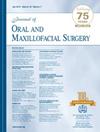Is Low-Level Laser Treatment Effective in Reducing Pain, Swelling, and Trismus After Removing Impacted Maxillary and Mandibular Third Molars?
IF 2.6
3区 医学
Q2 DENTISTRY, ORAL SURGERY & MEDICINE
引用次数: 0
Abstract
Background
The most common side effects of wisdom teeth removal are postoperative pain, swelling, and trismus. The efficacy of low-level laser treatment (LLLT) in reducing these side effects remains controversial.
Purpose
The purpose of this study was to evaluate the effectiveness of LLLT on pain, swelling and trismus after surgical removal of upper and lower wisdom teeth. The investigators hypothesize that the use of LLL will reduce pain, swelling and trismus compared to the mouth side treated with placebo laser (PL).
Study design
This double-blind, randomized, split-mouth study involved 20 (100%) healthy patients aged 18 to 24 years with asymptomatic impacted maxillary and mandibular third molars. Exclusion criteria included pregnant or lactating women, smokers, noncompliant patients, those with infectious diseases, anticoagulated patients, or those with intraoperative oral-antrum connection or previous pericoronitis. The study was conducted at the Clinic of Cranio-Maxillofacial and Oral Surgery, Center of Dental Medicine, University of Zurich, Switzerland.
Predictor variable
The predictor variable is the therapeutic intervention, LLL versus PL. Treatments were randomly assigned to LLL (ORCOS Medical AG, LASOTRONIC, Küsnacht, Switzerland) or PL.
Outcome variable
The primary outcome was pain 3 days postoperatively and the secondary outcomes were swelling and trismus 3 and 7 days postoperatively after wisdom teeth removal. Pain was measured using a visual analog scale, swelling was measured with an extraoral 3-dimensional scanner, and mouth opening with a ruler. The measurements were taken preoperatively and 3 and 7 days postoperatively. Age and sex were similar between the groups.
Covariates
The covariates were age and sex.
Analyses
A 2-sided Wilcoxon signed-rank test with a significance level α = 0.05 was used.
Results
The sample included 20 (100%) subjects with a mean age of 20.4 years (±1.9), 11 (55%) of whom were female. On day 3, the median pain score was 2.5 (interquartile range [IQR]: 3) in the LLLT group and 2.0 (IQR = 2.3) in the PL group (P = .5). The median swelling was 10,697 mm3 (IQR = 11,234 mm3) in LLLT versus 13,407 mm3 (IQR = 11,308 mm3) in PL group on day 3 (P = .1) and 2,379 mm3 (IQR = 4,322 mm3) in LLLT versus 1,553 mm3 (IQR = 3,079 mm3) in PL group on day 7 (P = .6). The median trismus was 35 mm (IQR = 9.8 mm) in LLLT versus 35.5 mm (IQR 9.5 mm) in PL group on day 3 (P = .7), and 43.5 mm (IQR = 11.3 mm) in LLLT versus 48 mm (IQR = 13 mm) in PL group on day 7 (P = .9).
Conclusion
Postoperative LLLT showed no statistically significant benefits in reducing pain, swelling, and trismus after wisdom teeth removal.
低水平激光治疗在去除阻生上颌和下颌第三磨牙后减轻疼痛、肿胀和牙关有效吗?
背景:拔除智齿最常见的副作用是术后疼痛、肿胀和牙关紧闭。低水平激光治疗(LLLT)在减少这些副作用方面的疗效仍然存在争议。目的:本研究的目的是评价LLLT对上、下智齿拔除术后疼痛、肿胀和牙关紧闭的疗效。研究人员推测,与使用安慰剂激光(PL)治疗的口腔一侧相比,使用LLL可以减轻疼痛、肿胀和牙关紧闭。研究设计:这项双盲、随机、裂口研究纳入了20例(100%)年龄在18 - 24岁、上颌和下颌第三磨牙无症状阻生的健康患者。排除标准包括孕妇或哺乳期妇女、吸烟者、不遵医嘱的患者、感染性疾病患者、抗凝血患者、术中有口腔连接或既往有冠周炎的患者。该研究在瑞士苏黎世大学牙科医学中心颅颌面口腔外科诊所进行。预测变量:预测变量为治疗性干预,LLL vs PL。治疗随机分为LLL (ORCOS Medical, LASOTRONIC, k snacht, Switzerland)或PL。结局变量:主要结局为术后3天疼痛,次要结局为智齿拔除后3天和7天肿胀和咬牙。疼痛用视觉模拟量表测量,肿胀用口外三维扫描仪测量,张嘴用尺子测量。分别于术前、术后3、7天进行测量。两组之间的年龄和性别相似。协变量:协变量为年龄和性别。分析:采用双侧Wilcoxon符号秩检验,显著性水平α = 0.05。结果:20例(100%)患者平均年龄20.4(±1.9)岁,其中11例(55%)女性。第3天,LLLT组的中位疼痛评分为2.5(四分位间距[IQR]: 3), PL组的中位疼痛评分为2.0 (IQR = 2.3) (P = 0.5)。第3天,LLLT的中位肿胀为10,697 mm3 (IQR = 11,234 mm3), PL组为13,407 mm3 (IQR = 11,308 mm3) (P = 0.1);第7天,LLLT的中位肿胀为2,379 mm3 (IQR = 4,322 mm3), PL组为1,553 mm3 (IQR = 3,079 mm3) (P = 0.6)。第3天,LLLT组中位牙关为35 mm (IQR = 9.8 mm), PL组为35.5 mm (IQR = 9.5 mm) (P = 0.7);第7天,LLLT组中位牙关为43.5 mm (IQR = 11.3 mm), PL组为48 mm (IQR = 13 mm) (P = 0.9)。结论:术后LLLT在减少智齿拔除后疼痛、肿胀和牙关咬合方面无统计学意义。
本文章由计算机程序翻译,如有差异,请以英文原文为准。
求助全文
约1分钟内获得全文
求助全文
来源期刊

Journal of Oral and Maxillofacial Surgery
医学-牙科与口腔外科
CiteScore
4.00
自引率
5.30%
发文量
0
审稿时长
41 days
期刊介绍:
This monthly journal offers comprehensive coverage of new techniques, important developments and innovative ideas in oral and maxillofacial surgery. Practice-applicable articles help develop the methods used to handle dentoalveolar surgery, facial injuries and deformities, TMJ disorders, oral cancer, jaw reconstruction, anesthesia and analgesia. The journal also includes specifics on new instruments and diagnostic equipment and modern therapeutic drugs and devices. Journal of Oral and Maxillofacial Surgery is recommended for first or priority subscription by the Dental Section of the Medical Library Association.
 求助内容:
求助内容: 应助结果提醒方式:
应助结果提醒方式:


